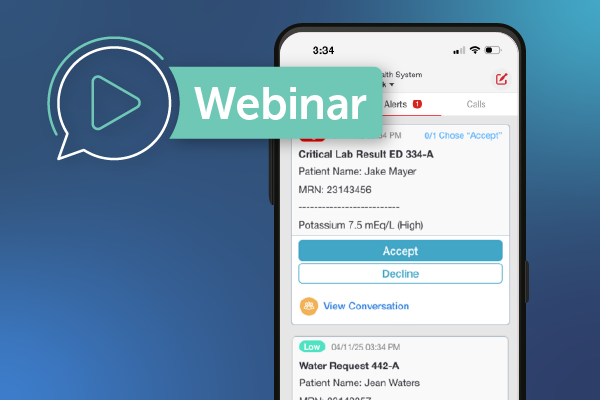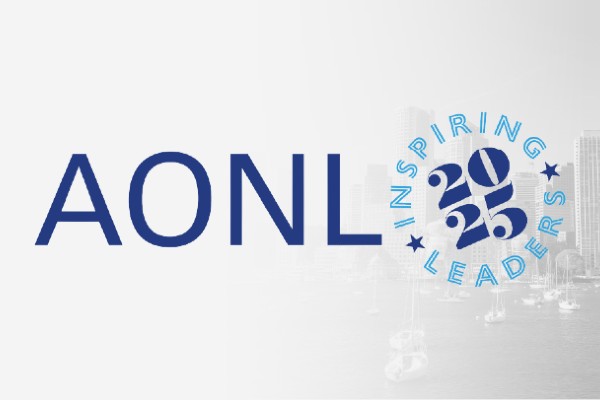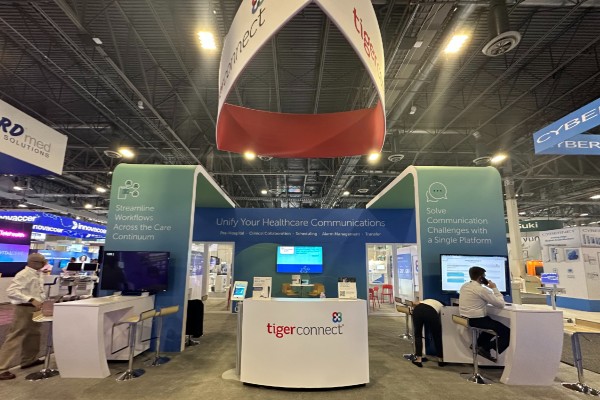
Streamline the Activation of Patient-centered, Operational and Rapid Response Teams
Another page comes across the overhead speakers on your floor. You listen diligently to discover the request is for a Code Blue… not your team. Although none of the day’s pages have been directed at you, it’s critical that you’re alert and attuned when the time comes. As you resume your duties, concentration broken, you take a second to collect your thoughts and recall what you were thinking just moments ago. The most prevalent thought now being on the time you’ve once again lost to disruption.
Overhead paging isn’t the only inefficiency in communication. Routing commonplace, but urgent requests through operators and dispatchers adds steps to the process. Receiving alerts through hand-held pagers requires a call-back to gather full context. Manually looking up and contacting every individual member of a rapid response team guarantees essential time will be lost. With many groups of workers within healthcare organizations operating as teams, it’s important that staff can quickly identify those groups and communicate consistently across them.
Enter TigerConnect Teams
To solve the challenge of targeted, team activation, TigerConnect is proud to introduce a powerful addition to our suite of TigerConnect Clinical Collaboration Platform – Pro collaboration tools. TigerConnect’s Teams consists of predefined yet customizable groups of Roles and individuals that can be activated on an event-by-event basis. Non-Teams members can easily alert, mobilize and communicate with specific Teams to quickly coordinate patient care. Teams are created and managed by your organization’s Teams admins.
Teams enhances TigerConnect Clinical Collaboration Platform – Pro’s existing workflow optimization features to help reach the right staff at the right time. Other key features include role-based messaging, scheduling integrations, and message escalations.
The Evolution of Teams
TigerConnect Teams was developed out of the need for any and all staff in a directory to be able to quickly activate a specific yet disparate group within the hospital or care setting. Being both publicly discoverable and allowing back-and-forth group communication was unique to existing functionality. Other TigerConnect group communication features, like private groups, can accommodate care-team communications, but are better suited for non-activation use cases.
Private groups are an alternative way to communicate with more than one individual or role at a time. Users can create groups and message amongst themselves, with only existing members able to add new ones. This is a great option if collaboration does not need to expand beyond the members of the team itself. The benefit that Teams offers over private groups is that they’re purposely discoverable to non-members. Users can quickly find a Team in the directory and activate it to begin communicating. They can also request to be added if they feel it’s relevant to them.
Another option for communicating to groups of users is Broadcast Lists. These lists are created by administrators and enable one-way communication to that group. This enables quick notification to specific staff, however, is not intended for collaboration. Teams’ two-way messaging functionality allows the group to communicate back to the activator, gather more information, and become better informed.
When to Use Teams
Often, emergent scenarios are what come to mind when discussing Team mobilization. Rapid Response Teams, STEMI, Stroke, Sepsis are examples of Teams that could receive an urgent request and need to collaboratively address the situation. Activating these teams through TigerConnect not only reduces overhead calls, but can also eliminate a convoluted pager hand-off. Bypassing overhead paging/phone calls and eliminating operators and call centers from these time-sensitive workflows helps expedite the care process.
Although urgent patient requests often come to mind for this type of “activation” functionality, the Teams feature also optimizes non-urgent clinical scenarios and non-clinical workflows as well.
Episodic Usage
These are patient-centered or one-time, event-focused collaboration scenarios. This type of Team can include inpatient admissions, surgery or other specialty-specific teams. Typically, the events are recurring with different patients or events being the focus each time. Activating these Teams in TigerConnect helps to ensure all pertaining staff are looped in and can collaborate in a centralized place, in turn driving better outcomes.
Cross Continuum Care
There’s no reason Teams usage needs to be limited to inside the four walls of your facility. Case management, transitions of care, and EMS are all groups that operate both inside and outside the facility as well as across health systems. A hospital may set up a TigerConnect Team to get activated when a patient needs assistance in setting up follow-up care, post-discharge. Streamlining the planning process before the patient returns home can help prevent readmissions.
Being easily accessible to staff is important, but even more, so is having the ability to dynamically join or leave Teams as needed. If it makes sense to be a part of a Team for a limited period of time, staff can request to join and then simply remove themselves when it’s no longer necessary.
Operational Teams
Not every team request is centered around a patient or even clinical in nature. Operational teams such as IT, revenue cycle, scheduling, and maintenance must be accessible at all times, but also frequently require more ongoing communication. As staff is manually or automatically opted into a role, they’ll immediately be able to see the existing Team conversations for a seamless handoff. Unique Team activations keep the conversation topics separate for more focused collaboration.
What’s Next
Teams is the next step in workflow optimization. It’s increasingly more important to not only reach an individual at the right time, but an entire group, while also ensuring the message is consistent for each recipient. Quick activation of Teams saves precious time in Code Situations, but also adds significant value for non-urgent and non-clinical ones as well. Click Here to learn more about how Teams can benefit your organization.
Featured Resources
Related Articles














